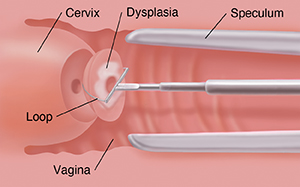LEEP stands for loop electrosurgical excision procedure. It's used to treat abnormal cell growth (dysplasia). A fine electrical wire loop is used to remove a small amount of tissue from your cervix. This can be done in the health care provider’s office. You can go back to your routine the same day. Schedule your LEEP for a time when you're not having your period. Tell your provider if you are pregnant or planning to get pregnant.
During the procedure
You’ll place your feet in stirrups. Your health care provider then inserts a speculum into your vagina. The speculum holds the walls of the vagina open to let the provider see the cervix:
-
Your cervix is numbed with a local anesthetic.
-
A mild vinegar or iodine solution may be applied to your cervix. This helps to highlight any dysplasia.
-
Your provider may look through a colposcope. This helps to get a close-up view of your cervix.
-
The loop is inserted through your vagina and moved toward the cervix.
-
The loop is used to remove a small piece of cervical tissue. You may feel pressure, a dull ache, or a cramp.
-
After the abnormal cells have been removed, a medicated solution or paste may be applied to the cervix. This helps reduce bleeding.
After the procedure
You may have a watery pink discharge and mild cramping after the procedure. Also, the solution used to decrease bleeding may cause dark vaginal discharge for a few days. Don't place anything in your vagina, such as tampons or douches, for a few weeks. You can use pads or panty liners. Do not have sex until your health care provider tells you it's okay. Your cervix should heal completely within a few weeks.
Your provider will schedule follow-up visits to:
-
Check your cervix.
-
See that there are no more abnormal cells and that they have not returned.
-
Do more tests to confirm their findings.
-
Discuss the treatment plan.
When to contact your doctor
Contact your health care provider right away if you:
-
Have heavy bleeding or bleeding with clots.
-
Have severe belly pain.
-
Have a fever.
-
Have foul-smelling vaginal discharge.
-
Faint or feel dizzy or lightheaded.
Featured in


